Alexander Litvinenko, Targeted by a Breadcrumb Trail of Deadly Radiation
/1 Comment/in Book Biz, News, Politics, History & Media, Philip Turner Book Productions /by Philip TurnerAgency Update: Some weeks after I wrote and published the post below, I licensed Amy Knight’s book to the Thomas Dunne Books imprint at St Martin’s Press. The manuscript is already being edited and the book, ORDERS FROM ABOVE: The Putin Regime and Political Murder, will be published in September 2017.
—
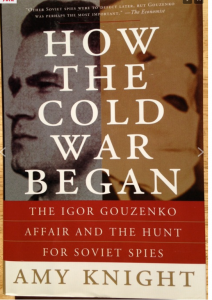 One of my author clients as a literary agent is a historian and scholar named Amy Knight. In 2006, when I was working as an acquiring editor at Carroll & Graf, I published her fifth book, How the Cold War Began: The Igor Gouzenko Affair and the Hunt for Soviet Spies, on the Soviet cypher clerk, Ghouzenko, who in September 1945 became arguably the first defector of the Cold War; he ultimately found asylum in Canada, and would later appear in media there disguised as he’s shown on the cover of the edition we brought out. I was amazed that this episode had occurred even while WWII was still ongoing. From Knight’s website, I note that she “earned her PhD in Russian politics at the London School of Economics and Political Science (LSE) in 1977….She’s taught at the LSE, Johns Hopkins, SAIS, and Carleton University in Ottawa, Canada and also worked for eighteen years at the U.S. Library of Congress as a Soviet/Russian affairs specialist. In 1993-94, she was a fellow at the Woodrow Wilson International Center for Scholars. Knight has written over 30 scholarly articles and has contributed numerous pieces on Russian politics and history to the New York Review of Books and the Times Literary Supplement. Her articles have also been published in the New York Times, the Washington Post, and The Wilson Quarterly.” She speaks Russian, and is especially knowledgable on the Russian security services, a veritable alphabet soup of state authorities that Putin has emphatically turned to his purposes since becoming Russian president in 1999.
One of my author clients as a literary agent is a historian and scholar named Amy Knight. In 2006, when I was working as an acquiring editor at Carroll & Graf, I published her fifth book, How the Cold War Began: The Igor Gouzenko Affair and the Hunt for Soviet Spies, on the Soviet cypher clerk, Ghouzenko, who in September 1945 became arguably the first defector of the Cold War; he ultimately found asylum in Canada, and would later appear in media there disguised as he’s shown on the cover of the edition we brought out. I was amazed that this episode had occurred even while WWII was still ongoing. From Knight’s website, I note that she “earned her PhD in Russian politics at the London School of Economics and Political Science (LSE) in 1977….She’s taught at the LSE, Johns Hopkins, SAIS, and Carleton University in Ottawa, Canada and also worked for eighteen years at the U.S. Library of Congress as a Soviet/Russian affairs specialist. In 1993-94, she was a fellow at the Woodrow Wilson International Center for Scholars. Knight has written over 30 scholarly articles and has contributed numerous pieces on Russian politics and history to the New York Review of Books and the Times Literary Supplement. Her articles have also been published in the New York Times, the Washington Post, and The Wilson Quarterly.” She speaks Russian, and is especially knowledgable on the Russian security services, a veritable alphabet soup of state authorities that Putin has emphatically turned to his purposes since becoming Russian president in 1999.
Titled Orders from Above: The Putin Regime and Political Murder, her new book promises to be the definitive account of the Kremlin’s lethal targeting of opponents inside Russia and in the West during the Putin years. A key part of it will chronicle in riveting tick-tock detail the 2006 murder-by-radiation of Alexander Litvinenko, who during the early part of his career was a member of the Russian security services, though by 1998 was a critic Russia’s security service devoted to counter-intelligence, organized crime, and anti-terrorism, the FSB. He had been in prison twice, for supposed insubordination. In 1999, terror struck in Moscow, when a whole apartment block was bombed, killing more than 300 people. The government quickly blamed it on Chechen insurgents, charging that the rebels, still smarting from their loss of the war in Chechnya earlier that decade were bent on revenge against ordinary Russians. But critics, including Litvinenko, believed the crime had emerged from within the regime, an atrocity committed to confirm a sort of bogeyman population in Russia’s midst, an internal enemy they could blame for many wrongs in the society. In 2000, after being released from prison a second time, he fled the country with his wife and son, eventually finding asylum in London where he found succor from another Putin critic, Boris Berezovsky, for whom he worked while continuing to agitate against Putin’s rule. In November 2006, he was poisoned with polonium-2010-laced green tea during a midday meeting with his clumsy assassins, who left a breadcrumb trail of radioactive contamination all over London, even on the airplane they’d boarded in Russia.
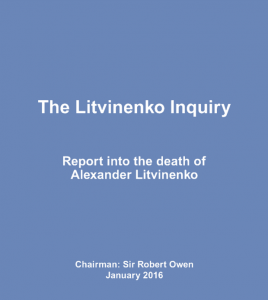 This morning in London, the British government released its official report on the death of Litvninenko, an inquiry long sought by his widow Marina. The magistrate, Sir Robert Owen, announced the findings to a tribunal where Knight was in attendance, on assignment from NY Review of Books editor Robert Silvers for the NYRB blog. As reported by the BBC and the NY Times, Owen accused “Andrei K. Lugovoi, a former KGB bodyguard, and Dmitri V. Kovtun, a Red Army deserter,” of poisoning Litvinenko at the Pine Bar in London’s Millennium Hotel on Nov 1, 2006. What’s more he laid the planning of the murder on the doorstep of the FSB, while concluding in careful, lawyerly language that Putin himself is “probably” responsible for Litvinenko’s ghastly death. When Knight posts her own report on the Inquiry, I’ll share the blog here.
This morning in London, the British government released its official report on the death of Litvninenko, an inquiry long sought by his widow Marina. The magistrate, Sir Robert Owen, announced the findings to a tribunal where Knight was in attendance, on assignment from NY Review of Books editor Robert Silvers for the NYRB blog. As reported by the BBC and the NY Times, Owen accused “Andrei K. Lugovoi, a former KGB bodyguard, and Dmitri V. Kovtun, a Red Army deserter,” of poisoning Litvinenko at the Pine Bar in London’s Millennium Hotel on Nov 1, 2006. What’s more he laid the planning of the murder on the doorstep of the FSB, while concluding in careful, lawyerly language that Putin himself is “probably” responsible for Litvinenko’s ghastly death. When Knight posts her own report on the Inquiry, I’ll share the blog here.
This is just the sort of ripped-from-the-headlines book I always enjoyed working on as an in-house editor, so I’m excited to be working with Amy Knight again, this time from the agent side of the desk.
Excited about Kyle Gallup’s New Line of Greeting Cards, IT’S A GIFT!
/0 Comments/in Art, Film, TV, Photography, Fine Printing & Design, Personal History, Family, Friends, Education, Travels /by Philip Turner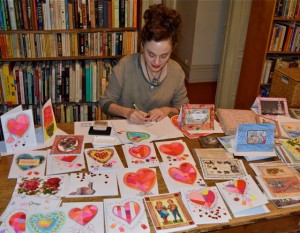 Happy to share word of IT’S A GIFT!, a line of new handmade greeting cards made by my wife, artist Kyle Gallup, including a batch of pretty valentines for the holiday next month. Here’s a link to the new Etsy page for her line—the name was inspired by the title of one our favorite movies, W.C. Fields’ 1934 comedy classic, “It’s a Gift.”
Happy to share word of IT’S A GIFT!, a line of new handmade greeting cards made by my wife, artist Kyle Gallup, including a batch of pretty valentines for the holiday next month. Here’s a link to the new Etsy page for her line—the name was inspired by the title of one our favorite movies, W.C. Fields’ 1934 comedy classic, “It’s a Gift.” 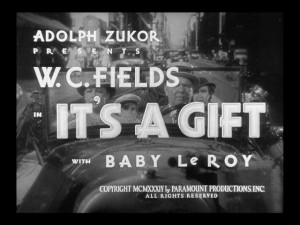
On the Etsy page, Kyle wrote this about herself and her work:
I’m a painter and I love making cards. For many years I have collected paper ephemera from Victorian scrap, bookend papers, maps, paper lace, and gold and silver embellishments, to name a few pieces in my collection. I’ve also collected cards from other artists and vintage ones, too. I find inspiration in what other artists make, present & past. Making cards is a way for me to share my enthusiasm with other people who enjoy giving and receiving cards as a way to show one’s affection in a personal and intimate way. My cards are made with love and are a gift from the sender to the receiver. Most of my handmade cards are 5″ x 6 1/2″ and all are collaged, painted, drawn and assembled by me. Each blank card is individual and one-of-a-kind. Tiny imperfections are the cards’ distinguishing mark, indicating they are handcrafted, and show the recipient that they are receiving a very special gift, something to be treasured. I’ve been a freelance decorative painter in the visual art department for the NYC home design company ABC Carpet & Home since 1988, and studied decorative finishes with Leonard Pardon in NYC.
Kyle also works in collage, so these are one-of-a-kind ‘artist’s cards,’ made using papers from her vintage collection of ephemera, plus paint, colored pencil, and ink. Each card is signed on the back and stamped with a logo she designed. Here are three of Kyle’s cards; each is $10 plus shipping, for sale at the Etsy page.


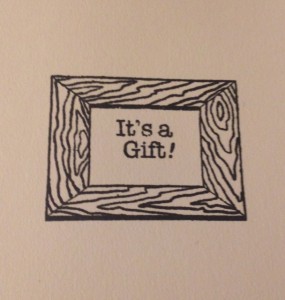

A High Point for the Concept Album—Procul Harum’s “A Salty Dog”
/0 Comments/in Music, Bands & Radio /by Philip Turner Rock music of the late ’60s and early ’70s may’ve been the Golden Age of the concept album—The Kinks’ “Arthur (Or the Decline and Fall of the British Empire),” The Who’s “Tommy,” and David Bowie’s “The Rise and Fall of Ziggy Stardust and the Spiders from Mars.” Amid so much amazing music, one of my favorites from the period was Procul Harum’s “A Salty Dog,” with a theme drawn from the Age of Sail when English ships plied the seas, filled with songs like “The Milk of Human Kindness,” The Wreck of the Hesperus,” and the eponymous “A Salty Dog,” songs about mariners and ships. I just listened to it again last night, and it still sounds great. I found someone had put it up on youtube, so if it’s new to you or an old fave, I hope you enjoy listening to it here!
Rock music of the late ’60s and early ’70s may’ve been the Golden Age of the concept album—The Kinks’ “Arthur (Or the Decline and Fall of the British Empire),” The Who’s “Tommy,” and David Bowie’s “The Rise and Fall of Ziggy Stardust and the Spiders from Mars.” Amid so much amazing music, one of my favorites from the period was Procul Harum’s “A Salty Dog,” with a theme drawn from the Age of Sail when English ships plied the seas, filled with songs like “The Milk of Human Kindness,” The Wreck of the Hesperus,” and the eponymous “A Salty Dog,” songs about mariners and ships. I just listened to it again last night, and it still sounds great. I found someone had put it up on youtube, so if it’s new to you or an old fave, I hope you enjoy listening to it here!
A New Flickr Album Chock-full of Hudson River and Great Gray Bridge Photos
/0 Comments/in Art, Photography, Design, Bicycling, Urban Life & New York City /by Philip TurnerAs readers of this blog may’ve noticed, I am fond of photographing the George Washington Bridge, the Hudson River, and sunsets along the shoreline on my regular bike rides in upper Manhattan. While I post many of those photographs in my social media accounts (on my Instagram; Facebook; and Twitter accounts), in truth I take more pictures than I can reasonably share on those platforms. Not all are good, but enough are that the circumstance motivated me to start a Flickr album I’ve labeled GGB/sunsets/Hudson as a repository for the greater bulk of those photos. If you enjoy those pictures, as many friends tell me they do, I invite you to visit the Flickr album for many more views of the sort like the ones shown here..
https://www.flickr.com/photos/127162161@N07/sets/72157663551324326
Did the Koch Brothers’ Help Dad Build an Oil Refinery for Adolf Hitler?
/0 Comments/in Books & Writing, News, Politics, History & Media, Philip Turner's Books & Writing /by Philip Turner Wow, this is going to be a blockbuster book. Jane Mayer’s latest, due out Jan 19th, is Dark Money: The Hidden History of the Billionaires Behind the Rise of the Radical Right. It’s the subject of a NY Times news article tonight by Nicholas Confessore who must’ve gotten an early copy. He reports on the collective portrait of rightwing billionaire families, including Richard Mellon Scaife, who before his death in 2014 spent more than a billion dollars of his Mellon family fortune pushing conservative causes; most notably, in the 1990s he harassed Bill Clinton through the infamous American Spectator magazine (see “Troopergate” if you need a reminder). I recall of this with firsthand memory because in the early 2000s I edited and published Susan MacDougal’s memoir of the years she was pursued by Whitewater Special Prosecutor Kenneth Starr, The Woman Who Wouldn’t Talk: Why I Wouldn’t Testify the Clintons and What I Learned in Jail., whose probe was an outgrowth of Scaife’s bankrolling Whitewater into a faux scandal. After discussing Scaife, the book examines an earlier brother pair, Lynde and Harry Bradley; and the DeVos family of Michigan. Apparently, Mayer then moves on to the bulk of her book, the Koch family. Confessore releases this explosive finding from Mayer’s investigation:
Wow, this is going to be a blockbuster book. Jane Mayer’s latest, due out Jan 19th, is Dark Money: The Hidden History of the Billionaires Behind the Rise of the Radical Right. It’s the subject of a NY Times news article tonight by Nicholas Confessore who must’ve gotten an early copy. He reports on the collective portrait of rightwing billionaire families, including Richard Mellon Scaife, who before his death in 2014 spent more than a billion dollars of his Mellon family fortune pushing conservative causes; most notably, in the 1990s he harassed Bill Clinton through the infamous American Spectator magazine (see “Troopergate” if you need a reminder). I recall of this with firsthand memory because in the early 2000s I edited and published Susan MacDougal’s memoir of the years she was pursued by Whitewater Special Prosecutor Kenneth Starr, The Woman Who Wouldn’t Talk: Why I Wouldn’t Testify the Clintons and What I Learned in Jail., whose probe was an outgrowth of Scaife’s bankrolling Whitewater into a faux scandal. After discussing Scaife, the book examines an earlier brother pair, Lynde and Harry Bradley; and the DeVos family of Michigan. Apparently, Mayer then moves on to the bulk of her book, the Koch family. Confessore releases this explosive finding from Mayer’s investigation:
“The book is largely focused on the Koch family, stretching back to its involvement in the far-right John Birch Society and the political and business activities of their father, Fred C. Koch, who found some of his earliest business success overseas in the years leading up to World War II. One venture was a partnership with the American Nazi sympathizer William Rhodes Davis, who, according to Ms. Mayer, hired Mr. Koch to help build the third-largest oil refinery in the Third Reich, a critical industrial cog in Hitler’s war machine.”
 As editor, I also acquired IBM and the Holocaust: The Strategic Alliance Between Nazi Germany and America’s Most Powerful Corporation (2001, Crown Publishing) by Edwin Black, and on this website blogged several times about The Collaboration: Hollywood’s Pact with Hitler by Ben Urwand. I have an eye for these sort of titles, and I’m sure this one by Mayer will be fascinating, and important.
As editor, I also acquired IBM and the Holocaust: The Strategic Alliance Between Nazi Germany and America’s Most Powerful Corporation (2001, Crown Publishing) by Edwin Black, and on this website blogged several times about The Collaboration: Hollywood’s Pact with Hitler by Ben Urwand. I have an eye for these sort of titles, and I’m sure this one by Mayer will be fascinating, and important.
As Alaska Notches 56 Years Since It Became a State, a Note on Ruth Gruber’s Role in the March to Statehood
/0 Comments/in News, Politics, History & Media, Philip Turner Book Productions /by Philip TurnerOn this date in 1959 Alaska became the US’s 49th State. Til then the Interior Department had a big hand in administering the territory, though there was also local government. Spanning 1941-46, Ruth Gruber—now 104, and the most senior living member of FDR administration—worked in the Cabinet-level department, and during that time served in Alaska as Secretary Harold Ickes’ Special Representative to the region. Her work there began in Spring 1941, a strategic place to be, especially when just six months later the Japanese air force bombed Pearl Harbor. After Hawaii, Alaska was the US’s other key Pacific outpost. She was a natural for the role in Alaska, which she got at age 29, as Harold Ickes had read her 1937 book I Went to the Soviet Arctic, a travelogue she wrote after becoming the first journalist or scholar—Westerner or Soviet, male or female—to travel in Siberia and observe the country’s population centers above the Arctic Circle. She explains how she got that earlier opportunity—after a Letter of Introduction to Soviet specialists by the mentor and Arctic explorer Viljalmur Stefanson, in her terrific memoir Ahead of Time: My Early Years as a Foreign Correspondent. One role she took on in Alaska was the establishment of homesteading in the vast land, anticipating especially the appeal the offer of land to settlers could have for US troops being demobilized as WWII ended. Her efforts helped lead ultimately to statehood, not even fifteen years following war’s end. You can read much more about Ruth’s career in her 18 books, 6 of which I helped her publish, many available nowadays from Open Road Integrated Media, and in my many blog posts about her, linked to here. Here she was photographed with local people.

